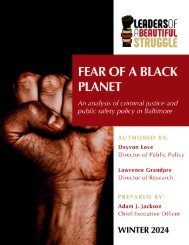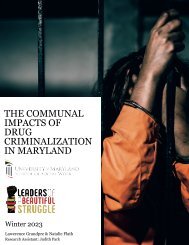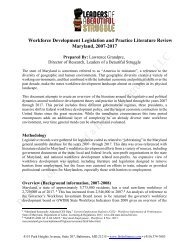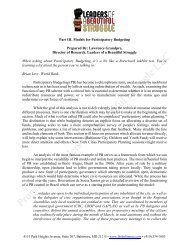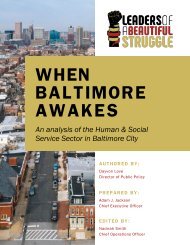Drug Decriminalization in Maryland Through an African Centered Research Paradigm- Analysis and Recommendations
This document offers guidance for theorizing questions related to a proposed research project purposed to advance drug decriminalization in Maryland.
This document offers guidance for theorizing questions related to a proposed research project purposed to advance drug decriminalization in Maryland.
- No tags were found...
You also want an ePaper? Increase the reach of your titles
YUMPU automatically turns print PDFs into web optimized ePapers that Google loves.
aga<strong>in</strong>st the victims ofWhite racist oppression amongst whom he himself is numbered.<br />
Look<strong>in</strong>g at the world through jaundiced white racist eyes, he sees the enemy:<br />
And the enemy is himself.” (Wilson,1990).<br />
<strong>Analysis</strong> of Black suicide rates have revealed that the Black suicide rate, far lower th<strong>an</strong> the<br />
rate of suicide <strong>in</strong> the white community, is nearly made up by a high number of Black homiciderelated<br />
deaths. Though correlation is not causation, the relationship between these two rates fits<br />
perfectly <strong>in</strong>to Wilson’s theory (NPR, 2013). This <strong>in</strong>sight not only places homicide rates <strong>in</strong> the<br />
Black community with<strong>in</strong> the proper historical context, it presents a path towards solutions to the<br />
issue, one that, co<strong>in</strong>cidentally, mirrors Kambon’s research on drug use. Creat<strong>in</strong>g <strong>in</strong>stitutions which<br />
c<strong>an</strong> address <strong>in</strong>ternalized self-hatred through the establishment of psycho-social <strong>in</strong>tegration with<strong>in</strong><br />
the Black community <strong>an</strong>d Afric<strong>an</strong> identity. Schiele presents ideas on how policy could address<br />
these dynamics, specifically among Black young people. Argu<strong>in</strong>g that hum<strong>an</strong> social service<br />
<strong>in</strong>terventions which center on spiritual work c<strong>an</strong> address violence, writ<strong>in</strong>g:<br />
“The fundamental recommendation that ensues from the latter discus-sion is to alleviate<br />
<strong>an</strong>d elim<strong>in</strong>ate spiritual alienation from the sociocultural fabric of the United States. Most<br />
of these activities would have to occur <strong>in</strong> the macroarenas of hum<strong>an</strong> service work, but there<br />
is <strong>an</strong> import<strong>an</strong>t role for microlevel hum<strong>an</strong> service <strong>in</strong>terventions as well. First, major<br />
knowledge validation <strong>an</strong>d <strong>in</strong>formation dissem<strong>in</strong>ation <strong>in</strong>stitutions <strong>in</strong> the United States<br />
should reexam<strong>in</strong>e concepts of the <strong>in</strong>herent nature of hum<strong>an</strong> be<strong>in</strong>gs. Institutions such as<br />
religious org<strong>an</strong>izations, schools, <strong>an</strong>d the media need to reexplore the value <strong>in</strong> promot<strong>in</strong>g<br />
the pessimistic, <strong>in</strong>herently mischievous image of hum<strong>an</strong>s <strong>an</strong>d the implications it has for<br />
foster<strong>in</strong>g unfavorable <strong>an</strong>d <strong>an</strong>tagonistic hum<strong>an</strong> relationships. This, of course, requires these<br />
<strong>in</strong>stitutions to reevaluate some of the core values of Eurocentric culture <strong>an</strong>d their<br />
contribution to <strong>an</strong> extraord<strong>in</strong>arily violent society.<br />
In regard to young people, these <strong>in</strong>stitutions must be particularly sensitive to youths<br />
because they are impressionistic <strong>an</strong>d because they represent the hope of improv<strong>in</strong>g society.<br />
One strategy that might be used to alleviate spiritual alienation <strong>in</strong> these <strong>in</strong>stitutions is to<br />
encourage a more holistic, spiritual, <strong>an</strong>d optimistic concept of hum<strong>an</strong> be<strong>in</strong>gs <strong>an</strong>d for adults<br />
to serve as greater behavioral models of this notion. This c<strong>an</strong> be achieved by promot<strong>in</strong>g<br />
<strong>an</strong>d teach<strong>in</strong>g holistic reason<strong>in</strong>g among youths to offset the focus on fragmented or <strong>an</strong>alytic<br />
reason<strong>in</strong>g, which some say lays the foundation for the objectification <strong>an</strong>d, ultimately, the<br />
exploitation of hum<strong>an</strong> be<strong>in</strong>gs (see Ani, 1994; Burgest, 1981; Schiele, 1994).<br />
4151 Park Heights Avenue, Suite 207, Baltimore, MD 21215 • www.lbsbaltimore.com • (410) 374-7683




